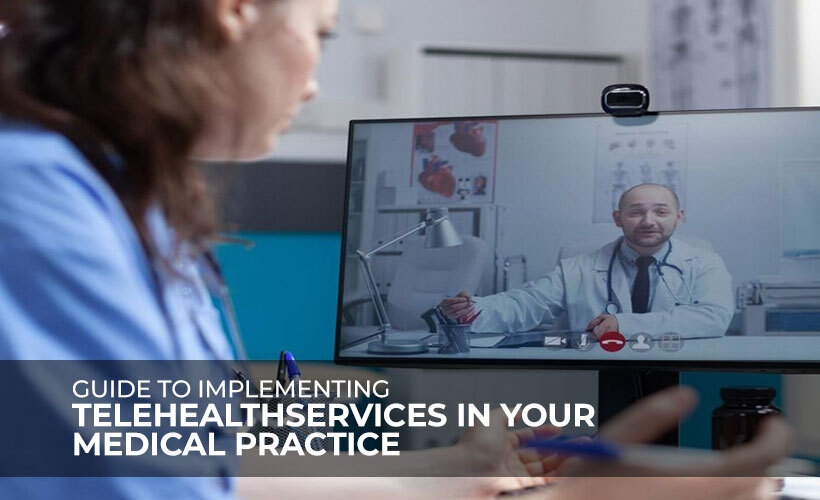

Telehealth has changed the way healthcare is delivered. It makes healthcare easier and faster for both doctors and patients. More people want easy access to care, especially in the United States. So, it’s important for medical practices to offer telehealth. Whether you live in a busy city or a small town, telehealth helps connect patients and doctors.
This guide will show you how to start using telehealth in your practice. It will help you make the change to this new way of providing care smoothly.
Table of Contents
What is Telehealth?
Telehealth is when technology is used to give healthcare from a distance. This means patients do not need to go to the doctor’s office. Instead, they can talk to their doctor by video calls, phone calls, or even text messages. There are many things telehealth can do. For example, patients can have virtual doctor visits, get their health checked from home, or see their health records online. They can also ask for prescriptions through digital platforms.
For example, a small clinic in Missouri may use telehealth to help patients living in nearby rural areas. This helps the patients save time and money because they do not need to travel far. With telehealth, patients can get care no matter where they live. It helps doctors reach more people and makes healthcare easier for everyone.
Benefits of Telehealth for Medical Practices
Adopting telehealth services has many benefits for your practice. More and more practices in the US are choosing telehealth.
Here’s why:
Expand Patient Reach
Telehealth helps you connect with patients who cannot visit in person. This is great for patients in far-away places or areas without many healthcare options.
Improve Flexibility
With telehealth, both patients and doctors can schedule visits easily. This helps avoid last-minute cancellations or no-shows.
Lower Operational Costs
Telehealth can save your practice money. It reduces the need for physical space and resources. Smaller practices, like those in New York, can save on office costs and still provide great care.
Indeed, telehealth benefits patients. It also helps your practice stay modern and focused on patients’ needs.
Steps to Implement Telehealth Services
Here are the steps to successfully implement telehealth services in your medical practice.
Step 1: Evaluate Practice Needs
Before starting telehealth, you must first understand your practice’s needs. Look at the patients you serve. Find out which services are best for remote care. For example, a pediatric practice may use telehealth for follow-up appointments. A family medicine clinic may use it to manage chronic diseases like diabetes.
Step 2: Choose the Right Telehealth Platform
Picking the right technology is very important. You need to find a platform that is:
- HIPAA-compliant: This keeps patient data safe.
- User-friendly: Both staff and patients should find it easy to use.
- Integrative: The platform should work well with your Electronic Health Record (EHR) system. This helps keep things running smoothly.
For example, a practice in Florida may choose a platform that lets them do video calls and send prescriptions.
Step 3: Ensure Regulatory Compliance
Laws about telehealth can change from state to state. It’s important to know:
- Licensing laws: Some states want providers to be licensed where their patients live.
- Insurance coverage: Check if services like telehealth are covered by Medicare, Medicaid, or private insurance.
Staying on top of these rules helps you avoid problems and keeps your telehealth practice working well.
Step 4: Train Staff and Educate Patients
Teaching your team is key. Give them hands-on training to show them how to use telehealth software. Teach them how to manage virtual appointments. At the same time, teach your patients. You can make videos or guides to help them. For example, you can make a simple video that shows how to log in and talk to a provider.
Step 5: Pilot the Program
Before fully starting telehealth, try it out first. Do a test run. This lets you:
- Get feedback from patients and staff.
- Find and fix any problems.
For example, a dermatology clinic in California might try telehealth for treating acne first. They can use this test to make sure everything works well.
Step 6: Launch and Monitor
After the test run, you can fully start your telehealth services. Keep track of how well it works. You can use patient surveys and data to see how effective it is. Make regular updates to the system to keep things running smoothly.
Challenges in Implementing Telehealth Services
Telehealth offers many benefits, but there are some challenges. These challenges can make it hard for medical practices to use telehealth services well.
- Technical Barriers
Not all patients or healthcare providers know how to use telehealth technology. Some patients may not have the right devices. They may also have problems with internet connections. This can make it hard for telehealth to work well.
- Patient Adoption Issues
Some patients may not want to use telehealth. They may not trust the technology. Possibly, they are more comfortable with in-person visits. They may be afraid of trying something new like virtual care.
- Regulatory and Compliance Hurdles
Telehealth rules can change often. The rules can also be different in each state. Medical practices need to know the latest rules. They need to stay updated on things like licensing, insurance, and privacy rules, like HIPAA.
- Privacy and Security Concerns
Keeping patient information safe is very important. Telehealth uses digital platforms. There is always a risk that patient data could be stolen. This is why keeping patient data safe is a big concern.
- Integration with Existing Systems
Telehealth services need to work with current systems. For example, they need to connect with Electronic Health Record (EHR) systems. This can be hard, especially if the old system does not work well with new telehealth platforms.
Solutions to Overcome Telehealth Challenges
To solve the challenges of telehealth, medical practices can use a good plan. First, they can help patients with technology. They can provide simple guides and video tutorials. If patients have bad internet, phone calls can be an option. This will make things easier. Next, it’s important to teach patients about telehealth. Practices can use newsletters and websites. They can also make their telehealth service easy to use. Asking patients what they think can help improve the service. If patients have problems, it’s good to listen to them.
Telehealth laws can be tricky. It’s important to stay up to date with the rules. Practices can work with telehealth providers who follow HIPAA rules. To keep patient data safe, practices should use HIPAA-compliant systems. They should also add extra steps to make sure only the right people can see the data. To make telehealth work with other systems, choose telehealth platforms that connect easily with EHR systems. It’s also a good idea to start with a test run. This will help fix any issues before fully launching the service.
Future of Telehealth in US Healthcare
The future of telehealth looks promising, especially with advanced technologies like AI and wearable health devices. These tools can provide real-time data for remote diagnostics, helping to enhance patient care.
For instance, a patient in Texas with a heart condition could use a wearable device to transmit vital information directly to their healthcare provider, allowing for proactive intervention. As telehealth continues to evolve, practices that embrace these innovations will stay competitive and well-prepared for the future of healthcare.
Implementing these technologies not only helps to improve patient access but also ensures that healthcare providers can offer timely and effective care. By keeping pace with changes in the healthcare landscape, telehealth can help practices deliver high-quality services in new and accessible ways.
Final Thoughts
Implementing telehealth services can change your medical practice. It can make it easier for patients to see doctors. It can also save time and improve patient happiness. By following the steps we shared, you can add telehealth to your practice. This will help you handle any problems that might come up.
The path to using telehealth may take some time and work. But the rewards are big. Your patients and your practice will both benefit. When you have the right tools and plans, the change will be easy. You will improve your patients’ experiences.
Using telehealth also helps your practice grow. It will help your practice do well in the future. As healthcare becomes more digital, telehealth will help you keep up.
Ready to transform your practice with telehealth?
Explore intuitive health services for expert guidance and support in implementing telehealth solutions tailored to your needs.
More Articles Read
https://americanexponent.com/neck-pain-left-side/
https://americanexponent.com/beauty-laser-hair-removal/





